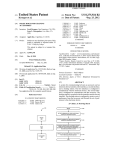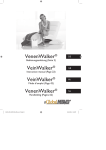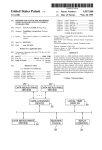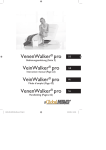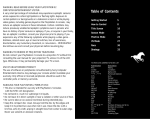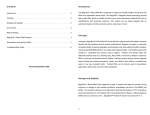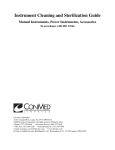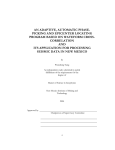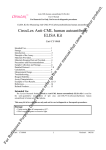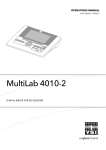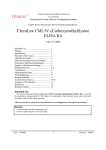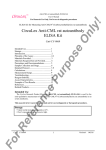Download Inactivation of Staphylococcus aureus bacteria
Transcript
Inactivation of Staphylococcus aureus bacteria by UVC irradiation produced by the TRU-D Device. Jeffery L. Deal, MD, FACS Marie Owens, Ph.D. November 30, 2001 To December 1, 2001 Purpose : susceptible persons. Renovation of aging hospitals increases risk of airborne fungal and other infections.1 This protocol will attempt to substantiate the claim the TRU-D is able to deliver doses of UVC in a predictable manner to areas of relative shadow in patient care areas Significant morbidity, mortality, and costs are associated sufficient to achieve at least a three log reduction of with these infections. Many factors contribute to these Staphylococcus aureus bacteria. dangerous infections. Most notably are the overuse of antibiotics and poor personal hygiene such as hand washing. Abundant evidence exists, however, that the hospital environment itself contributes to the problem by harboring Background : virulent strains of bacteria, fungi, and viruses, and that many methods commonly used are ineffective and may Nosocomial, or hospital acquired, infections are common, actually spread contaminants. Additional need exists for costly, and sometimes lethal. The nature of bacteria ac- remediation of biological contamination, both accidental quired in the hospital setting differs significantly from and as a result of acts of war or terrorism. bacteria found in a community setting primarily in their Other attempts to eradicate surface contaminates from the resistance to antibiotic therapy. hospital setting have varied greatly in strategy and sucHistorically, staphylococci, pseudomonads, cess. These have ranged from antiseptic soaps to fumigaand Escherichia coli have been the nosocomial tion with formaldehyde gas. Additionally, many surfaces infection troika; nosocomial pneumonia, surgisuch as keyboards, television sets, and monitoring concal wound infections, and vascular access-related trols are difficult if not impossible to decontaminate with bacteremia have caused the most illness and death liquid disinfectants without harming the electronics. in hospitalized patients; and intensive care units have been the epicenters of antibiotic resistance. Acquired antimicrobial resistance is the major problem, and vancomycin-resistant Staphylococcus aureus is the pathogen of greatest concern. The shift to outpatient care is leaving the most vulnerable patients in hospitals. Aging of our population and increasingly aggressive medical and surgical interventions, including implanted foreign bodies, organ transplantations, and xenotransplantation, create a cohort of particularly There are limited ways to eradicate microbes from areas of concern. Heating certainly is the standard method of achieving sterility of instruments but is not practical on large areas. Chemical disinfection is and will continue to be of use; however, as stated before, it is of limited success and usefulness on a large scale. Specifically, gas disinfection has been found to be time consuming, hazardous to workers, and environmentally unwise2 . Topical antiseptics are problematic for several reasons including 1 the concern that they may actually induce antibiotic resistances and thus may be adding to the problem of resistant strains. Ionizing radiation will kill in adequate doses but is hazardous and highly regulated. It is also difficult to contain in areas not specifically designed for such use such as x-ray suites. Certain wavelengths of non-ionizing electromagnetic radiation are also microbiocidal. It is this method of bacterial kill that is the subject of the present study. preferential absorption also plays a part in the microbiocidal effect of UVC. Sterilization of relatively small objects can be achieved quickly with intense exposure and is actually less destructive to certain materials than either chemical disinfection or heat.5,6 Several factors affect microbiocidal efficacy. Encapsulation, species-specific variations in transmission of light through cell membranes, species-specific repair activity, multi-layered colonies, temperature, and humidity may affect apparent lethal levels. Viruses tend to be more sensitive to UV damage than bacteria, and UV has been shown to be equally effective against some viral pathogens.7,8,9 Based upon the interaction with biologic material, ultraviolet light is categorized into three bands, UVA (400-315 nm), UVB (315-280 nm), and UVC (280-100 nm). UVC is the most microbiocidal bandwidth and is the type generated by the TRU-D. Ultraviolet (UV) light has been studied for disinfection and sterilization since the 1930’s3 . Recently, the widespread availability of low to medium pressure mercury bulbs has led to the development of devices that use UVC (also called UVGI) to decontaminate water supplies. At this time commercially available units exist for water sterilization, for air duct decontamination, and for the reduction of airborne bacteria via upward pointing light sources. To date, there are no published efforts to use UVC to decontaminate or disinfect larger areas such as operating rooms in a controlled and measured manner. The recent availability of appropriate bulbs as well as significant safety concerns regarding worker exposure to UVC likely contribute to the lack of efforts to use UVC outside of self-contained or low-powered systems. Interest in the possibility of using UVC to decontaminate or even sterilize work areas led to the building of the first prototype of this device in 1997. A patent pending has been in place for the subsequent variations of the device since September 19, 2000, and includes the device and variations thereof as well as the method of area sterilization. The first prototype used a UVC light source and motion detectors only. Initial tests were surprisingly successful with sterilization of bacteria from surfaces directly exposed to the irradiation. It became obvious, however, that some areas would not receive direct exposure from the lamp array. Methods of delivering adequate doses of UVC to these areas of relative shadow were explored. The idea developed that measuring doses that are reflected from walls and other enclosing surfaces would be a reliable, replicable, and controllable way to deliver adequate doses to areas not in direct line of sight of the device. This led to the development of a control mechanism to measure reflected doses and predict delivery of energy into areas of relative shadow. Since that time, other studies have been discovered that have observed the effect of germicidal activity in areas of relative shadow.10 UVC differs significantly from other forms of ultraviolet light in both its hazardous potential for human exposure and its germicidal activity. This quality also limits damage to human tissue to surface skin and the eyes. Shortterm exposure causes superficial burns, however, longterm exposure is highly carcinogenic. The properties that make UVC most microbiocidal also make it highly toxic. The microbiocidal effect of ultraviolet irradiation on bacteria and viruses is primarily due to the formation of pyrimidine dimers from thymine and cytosine, primarily thymine, in a photochemical reaction initiated by the absorption of photons4 . Such dimers inactivate resident DNA and RNA. With spores, it is postulated that UVC exposure results in the formation of lethal photo-products. The deactivation rate is complicated by the presence of genetic repair mechanisms resident in many if not all microorganisms.Viruses primarily utilize the repair mechanisms of host cells. Microbiocidal dose is a product of intensity and time. Shorter times and greater intensity appear most effective by shortening the time allowed to effect repair of damaged The TRU-D in present use is a mobile, automated room genetic material. In intense exposures thermal damage by sterilizer or decontamination device. Stationary units 2 would use the same techniques and strategy and could be Power output from the TRU-D is approximately 3000 built into the room itself. A stationary version of the pro- mW/cm2 at one meter and is believed to create the greattotype is a part of the original patent application. est amount of UVC that can be generated from a single twenty-amp circuit. Greater intensity can be generated in The TRU-D is positioned in a room, such as an operat- spaces with special, higher amperage circuits or by the use ing room or intensive care unit or an suspected to be con- of multiple units drawing from separate electrical circuits. taminated. A wireless remote control is used to activate Upon completion of the cycle, the unit has decontamithe device. For an initial interval after actuation, motion nated all the exposed surfaces within the room, including detectors sense movement, to assure that personnel have the primary shadows such as the back or wall side of all evacuated the space to be decontaminated. Subsequently, rails, cabinets that are not against the wall, and tables. In banks of mercury bulbs activate and generate intense lev- initial trials, actual sterility was achieved for most relevant els of UVC. After the bulbs are activated, an array of UVC surfaces. Trials of the TRU-D in actual operating rooms, sensors scan the room, and determine the darkest area, or endoscopy suites, and exam rooms as well as simulated the area reflecting the lowest level of UVC back to the trials have been performed. At direct exposure from two sensors. An on-board CPU in the device calculates the meters, the unit is able to reduce colony counts of comtime required to obtain a lethal dose of UVC reflected mon hospital pathogens by a minimum of 99.9% in one back from darkest area. The TRU-D transmits the cal- minute and achieved sterilization of most bacteria species culated dose of UVC, as well as other monitoring infor- in less than 10 minutes. Spore-forming microorganisms mation, to the remote control where it is displayed to the have been tested and proven sensitive to this technique.12 user. Once a lethal dose has been reflected to all the sen- Also, the ability of UVC to render bacteria inactive varies sors, the unit notifies the user and shuts down. By relying when tested on different materials. In general, the less on reflected doses rather than direct exposure, the TRU-D porous and more reflective materials are easier to deconis able to sterilize or decontaminate all surfaces within the taminate. 11,12 room that are within view of an exposed wall or ceiling. The pathogenic bacteria in the room have been effectively The TRU-D self monitors microbiocidal levels. Reflected eliminated. While it is possible to contaminate a surface doses of UVC are measured, and the device remains acthat is not reached by the TRU-D for decontamination, in tivated until appropriate levels are received. This ensures practical use the surfaces that are subject to contamination that areas in relative shadow and not in direct line of sight are also readily reached by the TRU-D for decontamina- with the unit are sterilized or decontaminated. Also, the unit can be set to deliver whatever dosing is required to detion. contaminate against a particular suspected species. Again, The dosing time is species dependent. Vegetative organ- while species specific variations exist regarding sensitivisms can be eradicated in some rooms, even in areas of ity to UVC, there are no organisms identified to date that relative shadow, in less than ten minutes11 . Spore form- are completely resistant to sufficient doses. ing organisms may take several hours. The device adapts itself to practically any size or configuration of rooms. In some situations, more than one unit will be required to decontaminate a large or geometrically complex space. Also, additional remote sensors can be attached for special situations where concern exists that the permanently attached sensors may provide inadequate information to predict germicidal levels of UVC. These sensors may be connected to the device via a data cord and placed in the area of greatest concern. The device then will be able to measure levels to this area and therefore assure adequate dosing of UVC. Without adequate safety features, daily use of intense UVC is dangerous and impractical. Since in actual use the mobile version of the TRU-D should not have power applied until it is ready to use, the TRU-D generates a voice alarm immediately when power is delivered. The voice alarm changes to reflect the mode of the device at whatever cycle it is in at the time. During the decontamination cycle the TRU-D repeats the verbal warning to keep clear of the room and to not attempt to look into the area being decontaminated. The device has motion detectors that assure the room is vacant of personnel prior to activation and will deactivate the unit at any segment of the 3 cycle when motion is detected. Hard-wired plugs on the unit are available for additional door, window, or other entry monitoring devices that special situations may dictate. If the TRU-D loses two-way communication with the remote control it also shuts down and sounds an audible alarm.Closed-loop, redundant safety circuits assure that no single electronic failure can result in the unit staying activated. the test surface and the control surface. Cell spreaders were then be used to spread the solution evenly across the surfaces. As drying occurred, the solution was repeatedly spread on the surfaces. Total drying time was 45 minutes, which included the time used to spread the solution. Step 2: The present test is to determine the dose of UVC required to inactivate Staphylococcus aureus Information derived in this test will be used in subsequent studies to provide dosing information entered into the algorithm used by the TRU-D device when an anthracis contamination of an area is suspected. The treatment room to be used measures 14 x 13 feet with a ceiling height of nine feet. The contaminated surface shall be placed a treatment room attached to the back of an exam chair, not in direct line of sight of the TRU-D. Contaminated surface shall therefore receive UVC dosing only by reflection from within the room and not directly from the bulbs. Three squares of the test grid and three squares of the control surface shall be randomly selected and cultured prior to any treatment of the test room. The TRU-D shall be placed in the room in compliance with the TRU-D User Manual. In order to confirm proper function of the device, the TRU-D shall be monitored by remote camera array and by positioning in the room at least two NIST traceable UVC sensors. An identical contaminated surface for each site shall be set aside in an area not exposed to UVC and used as a control. Serial dilutions shall also be done and plated to confirm the actual concentration of organisms in the stock suspension as well as to confirm the recovery method. Protocol : Materials • Staphylococcus aureus in a solution of 106 bacilli per milliliter of 0.5 McFarland solution. • Plate spreaders. • Aluminum plates measuring 1276 cm2 • Contact culture plates with 1 cm2 grid markings • TRU-D device. Step 3: • Radiometer calibrated to measure within the germicidal range of C-band ultraviolet light and calibrated Using safety protocols described in the TRU-D User Manaccording to NIST traceable standards. ual, the TRU-D and the radiometer are activated. The TRU-D shall stay active until 10% of the previously determined doses of UVC are applied to the room, confirmed Method by the on-board sensor array, and displayed to the operator. 1 Step 1 : Bacterial Challenge Inoculum Contact culture plates shall be used to recover organisms Staphylococcus aureus bacteria in a .5 McFarland solu- from the test and control surfaces. The TRU-D shall then tion was prepared by the Care Alliance Microbiology staff be reactivated until the device indicates that it has defor use in the trial. The solution was prepared on the livered what is predicted to provide sufficient energy to day of the trial. Serial dilutions in physiological saline achieve a three to six log reduction of organisms. After 1 According to previous tests, the decontaminating value has been was performed to achieve a final solution of 106 CFU per milliliter. Two milliliters of the solution was placed on determined to be 22,000 mW/S cm2 4 deactivation of the TRU-D, cultures shall again be taken fro each site and the control surfaces. This procedure will be repeated at intervals when the TRU-D indicates it has delivered 150%, 200%, and 300% of the predicted adequate dose. At each interval, contact culture plates shall be applied to randomly selected spaces following the manufacturer’s instructions for quantitative measurement of surface contamination. No surface area shall be cultured more than one time. At each interval, cultures shall also be taken from the unexposed control surfaces. Conclusion : Step 4: The TRU-D is purposefully programmed to over expose rather than under expose the areas being treated. It does so by measuring reflected levels to the device itself that logically is the longest distance light must travel within the area. It is possible that developing historical information in multiple settings may allow the algorithm used by the device to lessen the exposure time and still provide adequate dosing of UVC to appropriate areas. Measurements were taken from other areas of the examination room simultaneous to this trial. They included (see photos) the microscope facing away from the TRU-D and the surface of the cabinet. All surfaces measured intensities greater than the area behind the chair where the test surfaces were placed. 1. The TRU-D was able to achieve at lease a 4 log reduction in Staphylococcus aureus by reflection only in this treatment room in 9 minutes and 59 Seconds. 2. The TRU-D on board monitoring system predicted an appropriate exposure to occur in 16 minutes. Comments : Contact plates shall be incubated for 24 hours. Culture results shall be evaluated by direct enumeration and shall be reported as colonies per plate and extrapolated to the number of colonies per test surface area of 1276 cm2 . The results shall be analyzed for variability of results at a single exposure level between the types of surfaces tested. In addition, the average between the two plates for each level shall be plotted to display the rate of kill of microorganisms for each dose level compared to colony counts obtained from the untreated control surface. The measure of success of the TRU-D shall be expressed as its ability to deliver and predict levels of UVC adequate to achieve at least a three log reduction of viable organisms when compared to the control surfaces. Results: 1. Record colony-counts enumerated from contact plates at determined levels 2. Record TRU-D reflected doses 3. Report : Raw Data from 12/1/2001 % Predicted/Reflected Dose 10/ 100/ 200/ 300/ Colony Count Test Room 1 Colony County Test Room 2 Colony County Control 1 Colony County Control 2 1 0 0 0 1 0 1 0 500-1000 500-1000 500-1000 500-1000 500-1000 500-1000 500-1000 500-1000 5 References growth medium. This sterilization technique only requires a 20-second exposure to achieve sterility.” 1. “Nosocomial Infection Update.” Weinstein RA Cook County Hospital, Division of Infectious Diseases, Chicago, Il 60612 Emerging Infectious Diseases, 1998 July September; 4(3): 416-20. 7. “Evaluation of the effects of disinfectants on rotavirus RNA and infectivity by the polymerase chain reaction and cell-culture methods.”Ojeh CK, Cusack TM, Yolken RH. Johns Hopkins University School of Medicine, Department of Pediatric Infectious Diseases, Baltimore, MD 21287-4933, USA. ”Rotaviruses have been linked to outbreaks of acute gastroenteritis of children in day-care centres and hospital pediatric wards. There is, therefore, the need for monitoring effective decontamination of such environments. We have evaluated the effects of seven different method of disinfection/inactivation (four chemical and three physical) on rotavirus using the PCR and cell-culture methods. We observed that 6% H2O2, 2500 ppm chlorine, an ethano-phenolic disinfectant, u.v. irradiation and heat completely destroyed the infectivity of rotavirus as well as RNA amplifiable by PCR. On the other hand, treatment with 80% ethanol resulted in the loss of infectivity despite the fact that RNA was still amplifiable. Rotavirus subjected to drying over a 24 h period still retained amplifiable RNA but infectivity was reduced by 100-fold when compared to the control. This study demonstrated an agreement between PCR and cell-culture monitoring systems, however, PCR is a more rapid and sensitive assay.” 2. “Performing surface and room disinfection in the hospital” Durchfuhrung der Flachen- und Disinfection im Krankenhaus. Rehork B; Martiny H; Weist K; Ruden H Institut fur Hygiene der Freien Universitat Berlin. Gesundheitswes 1990 Jan;52(1):36-45 “Area disinfection methods under dispute were discontinued for medico-toxicological and environmental hygiene reasons.” 3. "A study of the bactericidal action of ultra violet light." Gates, F. L. (1929). J. Gen. Physiol. 13: 231-260. 4. N. Giese, J. Darby, Pergamon, Vol. 34, 2000, No. 16, pp. 4007-4014 5. “The fungicidal effect of ultraviolet light on impression materials.” J Prosthet Dent 1991 Apr;65(4):532-5 6. “Dynamic sterilization of titanium implants with ultraviolet light.” Int. J. Oral Maxillofac Implants 1989 Summer;4(2):139-46 Singh S, Schaaf NG. “All implantable devices must be sterile. However, autoclaves produce poor surface properties that jeopardize the integration process. The application of a modified ultraviolet light source has proven to enhance bio reactivity by controlling surface properties, but it lacks validation of its sterilization capabilities. Forty-eight titanium implants were contaminated with spores of the biological indicator Bacillus stearothermophilus and subjected to "dynamic sterilization" by ultraviolet light. Forty-seven of the implants were successfully sterilized, as indicated by not producing turbidity in a suitable 8. “ Susceptibility of HIV to inactivation by disinfectants and ultraviolet light.” J Hosp Infect 1995 Jul;30(3):167-80 9. “Quantitative evaluations of the effect of UV irradiation on the infectivity of HTLV-III (AIDS virus) with HTLV-I-carrying cell line, MT-4.” Nakashima H, Koyanagi Y, Harada S, Yamamoto N. 10. “Dialyzing room disinfection with ultra-violet irradiation.” Inamoto H, Ino Y, Jinnouchi M, Sata K, Wada T, Inamoto N, Osawa A. “Infections represent a major problem in dialysis treatment, thus the dialyzing room should be kept abacterial as possible. We have installed 15-watt 6 ultra-violet (U-V.) lamps for every 13.5 m2 on the ceiling for the purpose of the room disinfection and used them for 16 hours nightly after working hours. Bacteria were killed with over 10 hours irradiation even at the areas of low U-V. intensity where the irradiation may not be direct. This unexpected effectiveness might be from the influence of reflected rays and 03 produced. When half the lamps were turned on, the bacteriocidal effect was not sufficient in some areas. Any living organism with nucleic acids must be inactivated by this treatment, for the baceteriocidal effect is due to the nucleic acids injury. Furthermore, safety, readiness after the treatment, easy application and the negligible costs would make this method more advantageous to the other methods in room disinfection.” 11. “Investigations on disinfection and sterilization of surfaces by ultraviolet radiation” Dietz P, Bohm R, Strauch D. (Author translation) 12. Unpublished data collected by UVAS, LLC 7







